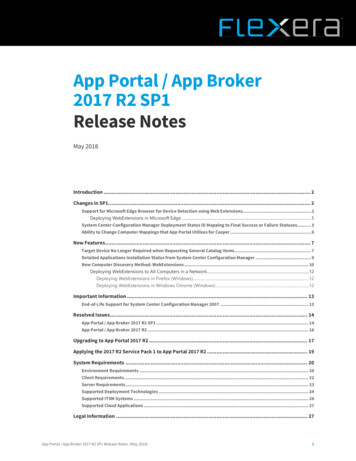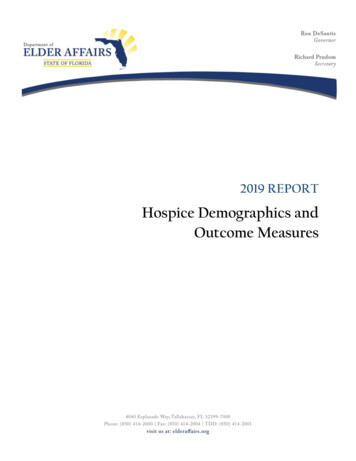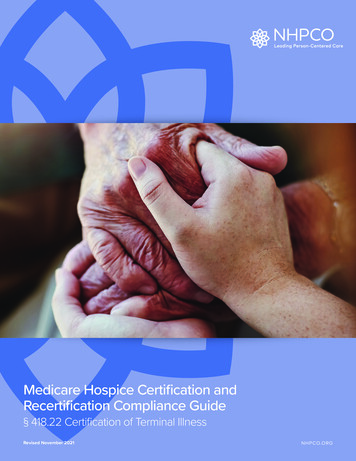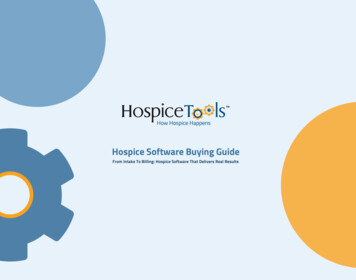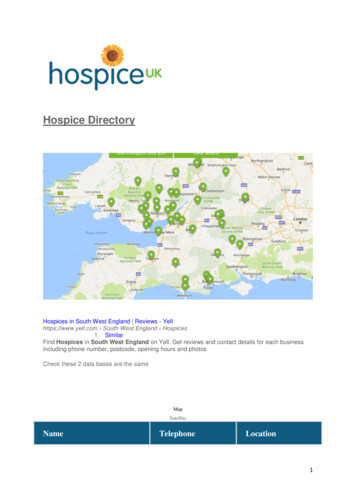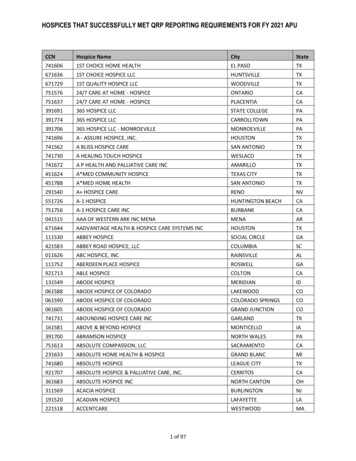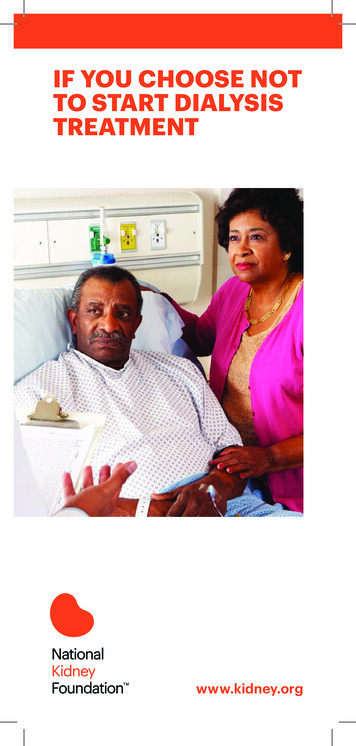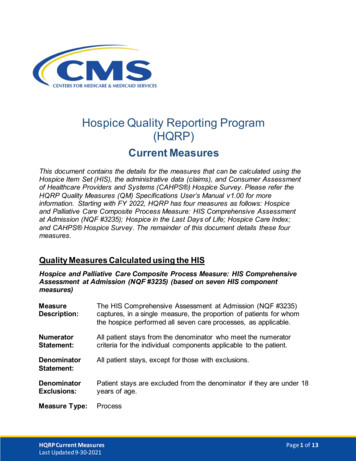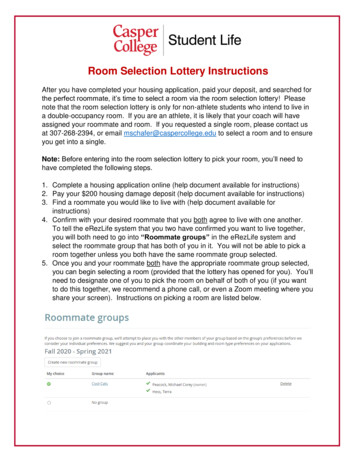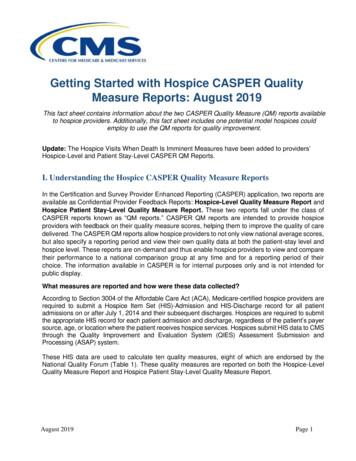
Transcription
Getting Started with Hospice CASPER QualityMeasure Reports: August 2019This fact sheet contains information about the two CASPER Quality Measure (QM) reports availableto hospice providers. Additionally, this fact sheet includes one potential model hospices couldemploy to use the QM reports for quality improvement.Update: The Hospice Visits When Death Is Imminent Measures have been added to providers’Hospice-Level and Patient Stay-Level CASPER QM Reports.I. Understanding the Hospice CASPER Quality Measure ReportsIn the Certification and Survey Provider Enhanced Reporting (CASPER) application, two reports areavailable as Confidential Provider Feedback Reports: Hospice-Level Quality Measure Report andHospice Patient Stay-Level Quality Measure Report. These two reports fall under the class ofCASPER reports known as “QM reports.” CASPER QM reports are intended to provide hospiceproviders with feedback on their quality measure scores, helping them to improve the quality of caredelivered. The CASPER QM reports allow hospice providers to not only view national average scores,but also specify a reporting period and view their own quality data at both the patient-stay level andhospice level. These reports are on-demand and thus enable hospice providers to view and comparetheir performance to a national comparison group at any time and for a reporting period of theirchoice. The information available in CASPER is for internal purposes only and is not intended forpublic display.What measures are reported and how were these data collected?According to Section 3004 of the Affordable Care Act (ACA), Medicare-certified hospice providers arerequired to submit a Hospice Item Set (HIS)-Admission and HIS-Discharge record for all patientadmissions on or after July 1, 2014 and their subsequent discharges. Hospices are required to submitthe appropriate HIS record for each patient admission and discharge, regardless of the patient’s payersource, age, or location where the patient receives hospice services. Hospices submit HIS data to CMSthrough the Quality Improvement and Evaluation System (QIES) Assessment Submission andProcessing (ASAP) system.These HIS data are used to calculate ten quality measures, eight of which are endorsed by theNational Quality Forum (Table 1). These quality measures are reported on both the Hospice-LevelQuality Measure Report and Hospice Patient Stay-Level Quality Measure Report.August 2019Page 1
Table 1. Quality Measures Reported on CASPER QM ReportsMeasure Title (NQF ID)Measure DescriptionTreatment Preferences (NQF #1641)The percentage of hospice patient stays withchart documentation that the hospice discussed(or attempted to discuss) preferences for lifesustaining treatments.Beliefs/Values Addressed (if desired bythe patient) (NQF #1647)The percentage of hospice patient stays withdocumentation of a discussion of spiritual andexistential concerns or documentation that thepatient and/or caregiver did not want to discuss.Pain Screening (NQF #1634)The percentage of hospice patient stays duringwhich the patient was screened for pain duringthe initial nursing assessment.Pain Assessment (NQF #1637)The percentage of hospice patient stays duringwhich the patient screened positive for painand received a comprehensive assessment ofpain within 1 day of screening.Dyspnea Screening (NQF #1639)The percentage of hospice patient stays duringwhich the patient was screened for dyspneaduring the initial nursing assessment.Dyspnea Treatment (NQF #1638)The percentage of hospice patient stays duringwhich the patient screened positive fordyspnea and received treatment within 1 dayof the screening.Patients Treated with an Opioid who areGiven a Bowel Regimen (NQF #1617)The percentage of patient stays withvulnerable adults treated with an opioid thatare offered/prescribed a bowel regimen ordocumentation of why this was not needed.Hospice and Palliative Care Composite ProcessMeasure: Comprehensive Assessment atAdmission (NQF #3235)The percentage of hospice stays duringwhich patients received a comprehensivepatient assessment at hospice admission.Hospice Visits When Death Is Imminent, last 3days of lifeThe percentage of patients receiving at leastone visit from a registered nurse, a physician,a nurse practitioner, or a physician assistantin the last three days of lifeHospice Visits When Death Is Imminent, last 7days of lifeThe percentage of patients receiving at leasttwo visits from a medical social worker, achaplain or spiritual counselor, a licensedpractical nurse, or a hospice aide in the lastseven days of lifeAugust 2019Page 2
Hospice-Level Quality Measure ReportThis report enables hospice providers to review their quality measure scores at the hospice-level andcompare their organization’s overall performance to the national average scores. Figure 1 illustrateshow to read this report. This report can assist hospice providers in their quality improvement processes. The report willenable hospice providers to identify on which quality measures they perform well and for whichquality measures they could develop quality improvement interventions to improve performance. Hospice providers can trend their quality measure results by comparing their quality measurescores and percentiles across multiple reporting periods, such as consecutive quarters.Trending the quality measure scores enables hospice providers to monitor the progress of thequality improvement interventions.August 2019Page 3
Figure 1. Breakdown of Hospice-Level Quality Measure Report1More information on how the numerator and denominator are determined and how quality measures are calculated see theQM User’s Manual (“Current Measures” link provided in Resources section, below)1Hospice Patient Stay-Level Quality Measure ReportThis report enables hospice providers to review the quality measure outcomes for all patient staysduring the reporting period. The report shows whether each patient stay triggered each qualitymeasure. Figure 2 illustrates how to read this report. This report is a companion report to the Hospice-Level Quality Measure Report, as this reportdrills down to patient-stay level information for each quality measure. Should quality measure scores on the Hospice-Level Quality Measure Report be less favorablethan anticipated, this report can assist a hospice to quickly assess which patient stayscontributed to the unfavorable results and then implement care processes to address theissues identified. This report can be used to assess quality of care concerns for specific patient populationsbased upon length of stay. For example, a hospice provider could review cases in which theadmission and discharge date were within the same month and year and for which the patientAugust 2019Page 4
did not achieve three or more of the quality measures, to determine if there are general qualityof care concerns for patients with this length of stay.This report indicates when an admission record was not submitted with an HIS dischargerecord (Type 2 Stay). This information could assist hospice in identifying when a missingadmission record should be submitted to the QIES ASAP system. See Chapter 3 of the HISManual (“HIS Technical Information” link provided in Resources section, below) for moreinformation about submitting HIS records.Figure 2. Breakdown of Patient-Stay-Level Quality Measure Report22 Moreinformation on how the numerator and denominator are determined and how quality measures are calculated see theQM User’s Manual (“Current Measures” link provided in Resources section, below)August 2019Page 5
II. Sample Process for Using the Measure Reports for Quality Improvement1. Obtain Hospice-Level Quality Measure Report.2. Use hospice-level performance on this report to identify on which quality measures yourhospice performs well and which quality measures need improvement.3. Obtain the Hospice Patient Stay-Level Quality Measure Report for the same report period thatwas selected for the Hospice-Level Quality Measure Report.4. Use the Hospice Patient Stay-Level Quality Measure Report to determine a sample of patientstays that triggered a specific quality measure (i.e., met the numerator criteria) and those thatdid not trigger that quality measure. The patient stays that did not trigger each quality measurereflect opportunities for quality improvement.5. Audit the charts for those sample patient stays to determine where there are opportunities toimprove care and where defined care processes were not carried out as planned. Identify rootcauses of why the care processes were not carried out as planned, which may require lookingbeyond chart data. For example, if all patient stays in a poor-performing quality measure wereunder the care of one nurse, discuss with the nurse about why sub-optimal care was delivered.In cases where excellent care was identified, note how those processes could be replicated andapplied to other patients.6. Implement changes in care processes related to the findings of the chart audits.7. Repeat this cycle monthly to drive quality improvement.III. Resources Available to Hospice Providers For more detailed instruction on accessing CASPER reports, please view the CASPERReporting Hospice Provider User’s Guide. For questions about access to CASPER, or specificprovider reports, please contact the QIES Technical Support Office (QTSO) Help Desk athelp@qtso.com or 1-877-201-4721. For questions about HIS record completion and submission processes, technical questions,questions for users who are registering for the QIES User ID, issues with the HART trainingmodules, and technical support for problems while using the HART software, please contactthe QTSO Help Desk at Help@qtso.com or 1-877-201-4721. Hospice providers should visit the HIS Technical Information portion of the CMS HQRP websitefor more information on submitting HIS data to CMS, and information on using the HART,CASPER, and QIES ASAP systems. For more information on how quality measures are calculated see the HQRP QM User’s Manualin the Downloads section of the Current Measures portion of the CMS HQRP website. For questions about HIS and general questions about the HQRP program, reportingrequirements, quality measures, and reporting deadlines, please contact the QualityHelp Desk at HospiceQualityQuestions@cms.hhs.gov.August 2019Page 6
This fact sheet contains information about the two CASPER Quality Measure (QM) reports available to hospice providers. Additionally, this fact sheet includes one potential model hospices could employ to use the QM reports for quality improvement. Update: The Hospice Visits When Death Is Imminent Measures have been added to providers'
